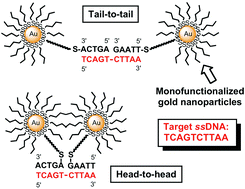DNA hybridization of pathogenicity island of vancomycin-resistant Enterococcus faecalis with discretely functionalized gold nanoparticles in organic solvent mixtures
Abstract
Short single-strand (ss) DNA sensors that involve mono-functionalized

* Corresponding authors
a
Centre of Novel Functional Molecules and Institute of Molecular Functional Materials, Department of Chemistry, The Chinese University of Hong Kong, Shatin, NT, Hong Kong SAR, P.R. China
E-mail:
cfleung@cuhk.edu.hk
b School of Biomedical Sciences, The Chinese University of Hong Kong, Shatin, NT, Hong Kong SAR, P.R. China
c Institute of Creativity and Department of Chemistry, The Hong Kong Baptist University, Kowloon Tong, Kowloon, Hong Kong SAR, P.R. China
Short single-strand (ss) DNA sensors that involve mono-functionalized

 Please wait while we load your content...
Something went wrong. Try again?
Please wait while we load your content...
Something went wrong. Try again?
C. Chak, J. M. Y. Lai, K. W. Y. Sham, C. H. K. Cheng and K. C. Leung, RSC Adv., 2011, 1, 1342 DOI: 10.1039/C1RA00304F
To request permission to reproduce material from this article, please go to the Copyright Clearance Center request page.
If you are an author contributing to an RSC publication, you do not need to request permission provided correct acknowledgement is given.
If you are the author of this article, you do not need to request permission to reproduce figures and diagrams provided correct acknowledgement is given. If you want to reproduce the whole article in a third-party publication (excluding your thesis/dissertation for which permission is not required) please go to the Copyright Clearance Center request page.
Read more about how to correctly acknowledge RSC content.
 Fetching data from CrossRef.
Fetching data from CrossRef.
This may take some time to load.
Loading related content
